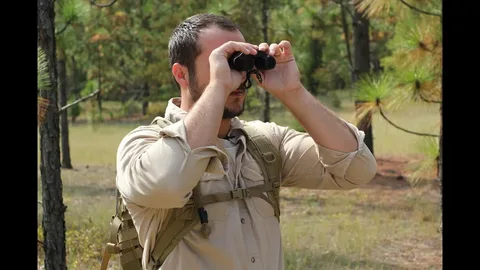When you’re heading into the backcountry or sitting still on a ridge, what you see—or don’t see—can make all the difference. Good binoculars let you spot movement, read terrain, and plan your approach without disturbing game. In short: you “glass before you step,” meaning you observe first, move second. Below, we’ll explore how smart use of shooting binoculars can raise your odds, boost safety, and sharpen your hunting instinct.
The Role of Glassing in Modern Hunting
Scouting by foot has its place, but glassing gives you a powerful advantage. From a high point, ridge, or concealed vantage, binoculars allow you to see beyond your immediate surroundings. You can pick up deer in valleys, detect movement on distant slopes, or locate bedding areas—all while conserving energy. In fact, many seasoned hunters say success in the field often starts long before the shot, in the hours spent observing.
Crucially, glassing also helps you avoid mistakes: misidentification, bad approaches, or spooking your target. If you see signs like fresh tracks or animals feeding from a distance, you can plan a better route rather than walking blind into danger or disturbance. A good pair of optics becomes a kind of field insurance.
What to Look for in Binoculars for Scouting
Not all binoculars are equal, especially in the rugged world of hunting. For scouting, clarity, reliability, and comfort matter most. First, magnification matters: a 10×42 or 8×42 model is often ideal because it gives reach without excessive shake. Very high magnification can narrow your view and make images wobbly.
Next, glass quality and coatings are vital. The best binoculars are “fully multi-coated,” meaning each air-glass surface gets treatments to reduce glare and boost light transmission. That means sharper images even in dawn or dusk light. Waterproofing and fog-proofing (using nitrogen or argon purging) ensure your lenses don’t cloud when temperatures shift—essential when you’re out in changing conditions.
Also consider ergonomics—weight, grip, and how your hands feel on them over long hours. You don’t want optics that feel awkward or fatigue your arms before you even start glassing.
Tactics for Smarter Scouting
With good binoculars in hand, your technique matters. Start where you are: glass the terrain before you make a move. Break the landscape into a mental grid and slowly scan left to right, top to bottom. Cover ridgelines first, where animals often travel or bed.
Move slowly. Rapid shifts create clutter in your view, making it easy to miss subtle motion. When you see movement—big or small—focus on that zone, lower magnification if needed, and study details (shape, color, positioning). Sometimes the head or tail motion gives away an animal more clearly than its body.
Change vantage points. A spot that looked empty from one angle might hide game behind a rise or a brush ridge. Move elevation if you can, and re-glass from different perspectives before committing to an approach.
Safety and Stealth Benefits
Glassing before stepping doesn’t just help with success—it also improves safety. For one, you reduce the risk of walking into dangerous terrain or thick brush without knowing what lies ahead. You can spot steep drop-offs, cliffs, or obstacles far sooner.
Also, by observing without moving, you reduce disturbance. Game is less likely to notice you if you stay put and let your optics do the work. Once you’ve zeroed in on the target zone, move quietly and deliberately. If animals shift or react while you approach, you’ve already spotted signs you might have missed otherwise (like flicking ears or tail swishes).
In crowded hunting areas, glassing also helps you spot other hunters or movement that could pose danger. You’ll see distant muzzle flashes, clothing, or silhouettes before walking blind into zones where others are active.
Choosing and Caring for the Right Optics
Choosing the right binoculars is a balance of features, price, and use. A set of shooting binoculars built for rugged environments and clarity can give you more confidence in the field. Look for durable housing, rubber armor, and optics that hold calibration even after knocks or drops.
Once you have good binoculars, care matters. Always keep ear and objective lens caps on when not in use, clean lenses with a blower then micro fiber cloth, and avoid direct contact with dirt or humus. Store them in a dry case to protect seals and prevent mildew or haze. Test them occasionally by glassing known landmarks to make sure they’re still sharp and aligned.
Over time, if your binoculars start showing distortion, blurring on one side, or internal fogging, it’s time to service or replace them. A compromised view can cost you real opportunities (or worse, lead you into a poor approach).
Let Your Optics Do the Walking
Scout with your eyes first—move with purpose second. A good set of binoculars doesn’t replace boots or effort, but it sharpens your edge. You’ll move more intelligently, avoid mistakes, and find game more consistently.
Next time you step into the field, take a moment: glass before you step. Let your optics show you the lay of the land, the hidden movement, and the path that leads to success. In the wild, what you see first often decides what you do next.


